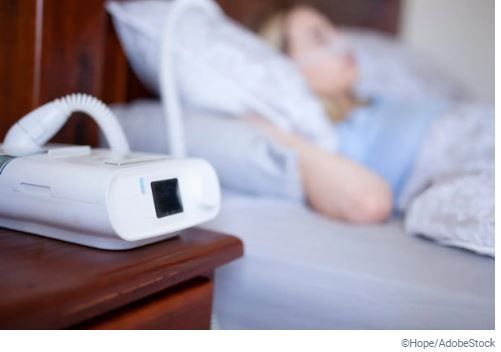- CDC
- Heart Failure
- Cardiovascular Clinical Consult
- Adult Immunization
- Hepatic Disease
- Rare Disorders
- Pediatric Immunization
- Implementing The Topcon Ocular Telehealth Platform
- Weight Management
- Monkeypox
- Guidelines
- Men's Health
- Psychiatry
- Allergy
- Nutrition
- Women's Health
- Cardiology
- Substance Use
- Pediatrics
- Kidney Disease
- Genetics
- Complimentary & Alternative Medicine
- Dermatology
- Endocrinology
- Oral Medicine
- Otorhinolaryngologic Diseases
- Pain
- Gastrointestinal Disorders
- Geriatrics
- Infection
- Musculoskeletal Disorders
- Obesity
- Rheumatology
- Technology
- Cancer
- Nephrology
- Anemia
- Neurology
- Pulmonology
CPAP Compliance Improves Lung Function in Patients with Comorbid OSA and COPD
Among patients with COPD and OSA, those with consistent CPAP compliance over 12 months showed improved lung function and experienced fewer AECOPD.

Patients with good compliance to continuous positive airway pressure (CPAP) treatment had a lower number of acute exacerbations related to chronic obstructive pulmonary disease (AECOPD) and showed improved lung function and COPD-related symptoms, compared to those with poor compliance, according to a study on patients with overlap syndrome (OS) for comorbid obstructive sleep apnea (OSA) and COPD.
The results of this prospective observational study were published in The Clinical Respiratory Journal.
"Patients with COPD can have a rather stable course of disease; however, exacerbations may occur, which are characterized as an acute worsening of respiratory symptoms that necessitates a change in COPD current treatment or hospital admission," the researchers wrote. "Exacerbations represent a significant medical and public healthcare burden, as they are related to poor quality of life, disease progression and worse survival."
This study followed a total of 59 patients (54 men, 5 women) diagnosed with OS, who underwent CPAP treatment for 12 months. Participants enrolled in this study were consecutive patients with COPD who had been referred for evaluation of sleep disordered breathing from November 2017 to June 2020, and who had been diagnosed with OSA.
"[COPD] exacerbations represent a significant medical and public healthcare burden, as they are related to poor quality of life, disease progression and worse survival."
Participants were aged ≥40 years, were current or former smokers with at least a 10 pack-year smoking history, had a diagnosis of stable COPD in the last month, and had received bronchodilation treatment before the sleep study.
The participants were divided into 2 groups: group A (with good treatment compliance) and group B (with poor treatment compliance).
Group A participants (n = 29) were instructed to use a CPAP machine for ≥4 hours each night. The participants in group B (n = 30) were instructed to use a CPAP machine for <4 hours each night.
All participants underwent assessments at baseline and 12 months after CPAP treatment, including anthropometric parameters, COPD symptoms (assessed using the COPD Assessment Test [CAT] and modified British Medical Research Council [mMRC] questionnaires), pulmonary function testing, and a 6-minute walking test (6MWT)
FINDINGS
At 12 months, group A showed improvements in forced expiratory volume in the first second (P = .024), total lung capacity (P = .024), ratio of residual volume (RV) to total lung capacity (TLC) on pulmonary function testing (RV/TLC) (P = .003), 6MWT (P < .001) and CAT (P < .001) scores.
Additionally, the patients with good CPAP compliance had a decrease in COPD exacerbations from baseline to 12 months (17 before vs 5 after; P = .001), while the patients with poor CPAP compliance did not see a difference in COPD exacerbations (15 before vs 15 after; P = 1.0). Furthermore, COPD exacerbations were associated with poor CPAP compliance (b = 0.362; 95% CI, 0.075-0.649; P = .015).
The researchers acknowledged that this study had some limitations, including its observational nature that only included a relatively small number of participants. Second, there was an overrepresentation of men to women, which the researchers suggest may reflect a higher prevalence of OS in men.
However, the findings of this study provide insight on the benefits of CPAP compliance when treating patients with OS.
“In summary, the results of this real-life observational study denote that CPAP use reduces the number of AECOPD and is beneficial for several COPD related outcomes in a cohort of OS patients,” concluded the researchers. “Moreover, this study addresses the central role of compliance to OSA treatment with CPAP on the management of these patients, a finding that merits further research in the field of OS.”
This article originally appeard on partner site the American Journal of Managed Care.
Reference: Voulgaris A, Archontogeorgis K, Anevlavis S, et al. Effect of compliance to continuous positive airway pressure on exacerbations, lung function and symptoms in patients with chronic obstructive pulmonary disease and obstructive sleep apnea (overlap syndrome). Clin Respir J. Published online January 12, 2023. doi:10.1111/crj.13580
